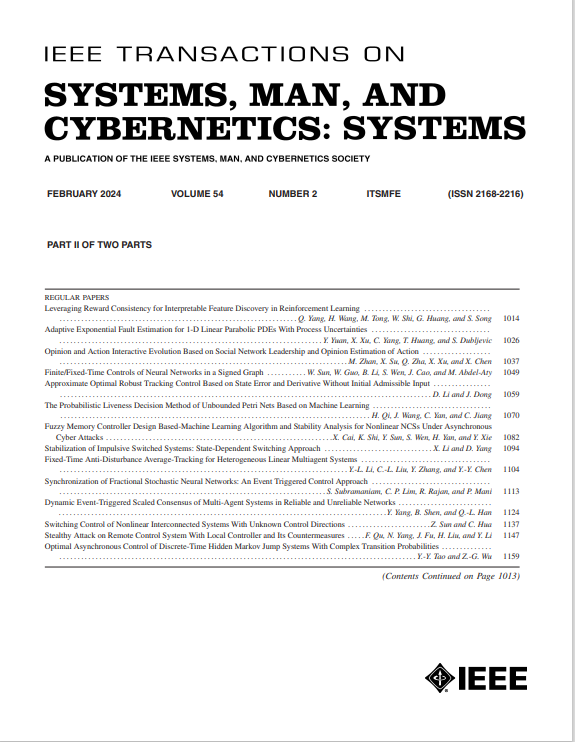多非完整移动机器人簇复合运动缠绕的自适应摄动抑制控制
IF 8.7
1区 计算机科学
Q1 AUTOMATION & CONTROL SYSTEMS
IEEE Transactions on Systems Man Cybernetics-Systems
Pub Date : 2025-07-10
DOI:10.1109/TSMC.2025.3580449
引用次数: 0
摘要
非完整移动机器人群中速度和加速度复合卷绕的存在会严重制约整体运动的平稳性和稳定性。提出了一种基于leader - follower的分布式群体控制框架,用于速度、加速度复合卷绕和未知扰动下的多非完整移动机器人平滑鲁棒聚类。通过反馈线性化技术模块化设计解耦的位置和姿态运动学和基板车轮速度动力学,实现上层协同误差调节和下层车轮速度轨迹跟踪。将基于复合运动卷绕产生的速度包络和WMR运动学的辅助动力系统集成到协同误差中,自适应地减轻了有害的卷绕效应。采用自适应饱和扩展状态观测器对车轮速度动力学中的未知扰动进行平面估计,增强了系统的鲁棒性。最后,基于Lyapunov定理对系统进行了总体稳定性分析,并进行了对比仿真和大量实验,验证了算法的有效性和可用性。本文章由计算机程序翻译,如有差异,请以英文原文为准。
Adaptive Perturbation Suppression Control for Multiple Nonholonomic Mobile Robot Clusters Against Composite Motion Windups
The existence of compound velocity and acceleration windups in clusters of nonholonomic mobile robots can seriously constrain the smoothness and stability of the overall motion. This article proposes a leader–follower-based distributed formation control framework for smooth and robust clustering of multiple nonholonomic mobile robots under compound windups of velocity and acceleration and unknown perturbations. The decoupled position and orientation kinematics and substrate wheel velocity dynamics are modularly devised via feedback linearization techniques to enable upper-level cooperative error regulation and lower-level wheel velocity trajectory tracking. The auxiliary dynamic system based on the velocity envelope generated by compound motion windups and the WMR kinematic is integrated into the collaborative error, adaptively mitigating the detrimental windup effects. The adaptive saturated extended state observer is utilized to flatly estimate unknown perturbations in the wheel velocity dynamics with enhanced robustness. Finally, the overall stability analyses are done based on Lyapunov’s theorem, and contrastive simulations and plentiful experiments are conducted to attest to the validity and availability.
求助全文
通过发布文献求助,成功后即可免费获取论文全文。
去求助
来源期刊

IEEE Transactions on Systems Man Cybernetics-Systems
AUTOMATION & CONTROL SYSTEMS-COMPUTER SCIENCE, CYBERNETICS
CiteScore
18.50
自引率
11.50%
发文量
812
审稿时长
6 months
期刊介绍:
The IEEE Transactions on Systems, Man, and Cybernetics: Systems encompasses the fields of systems engineering, covering issue formulation, analysis, and modeling throughout the systems engineering lifecycle phases. It addresses decision-making, issue interpretation, systems management, processes, and various methods such as optimization, modeling, and simulation in the development and deployment of large systems.
 求助内容:
求助内容: 应助结果提醒方式:
应助结果提醒方式:


